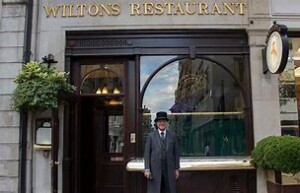 It’s instructive to get an American view of some British institutions. So here are Peter Passell and Leonard Ross on ‘The Best London Restaurant’.
It’s instructive to get an American view of some British institutions. So here are Peter Passell and Leonard Ross on ‘The Best London Restaurant’.
The trouble with eating in London is that it is like eating in New York. There are vast hordes longing to dine well and dozens of exciting new restaurants longing to fill the void. Yet somehow nothing seems to work out. Perhaps it is only a scarcity of talent—-running a restaurant well demands more than one chef imported from the Continent. More likely it’s incentives. There aren’t enough people who both know good food and are willing to pay for it. Restaurants are made or broken by who shows up, not by what is served. The few establishments that start out with standards find little reason to maintain them. No guidebook inspector will turn the decline into headlines; no army of food pedants will organize a boycott.
Of course, there are a few bright spots. Robert Carrier’s relentless pursuit of the nouveau may irritate the snob, but the fixed menus frequently work well. Inigo Jones’s lovely room can make up for an occasional error in service. The fish is very fresh ( and very expensive) at Wilton’s. The new Capital Hotel dining room produces the best rack of lamb north of Paris. Marynka demonstrates that Polish food is no joke.
But for our money we’ll take London’s Indian/Pakistani restaurants. They tend to be much more sophisticated than the North American version and not nearly so lacking in grace. The best of them, Sri Lanka, is in fact not Indian but Ceylonese, a variant on the national cuisines of the subcontinent. This pretty little restaurant near Earl’s Court ( an unsocial twenty-minute taxi ride west from Mayfair) prepares the predictable curries, flavored rices, and breads as well as well as any other in London and adds a dozen distinguished Ceylonese specialties. Among them, a super-hot tomato broth ( perhaps really a puree of chili peppers), the pleasure of which comes in the vibration of subtler spices in the aftertaste; delicate rice-flour crepes served with fried eggs; chewy fried breads stuffed with egg, vegetables , or meat, and far superior to the usual Indian paratha; a steamed rice-flour cake drowned in coconut milk. With a couple of German lagers, the bill comes to two pounds per person.
Today, the eating scene in London has changed incredibly. Here you can eat around the globe, from Brazil to Russia and Indonesia to California, often from street stalls in Brick Lane and Portobello Road, a development that Passell and Ross could hardly have imagined. The Indian/Pakistani restaurants are still there, of course, and are proliferating day by day. It is odd that our Americans fail to mention the curry houses centered on Brick Lane, and further east, in and around Whitechapel High Street, where the best of them offer high-class ‘ home-cooking ‘ of the kind described by the authors. But it is true that Sri Lankan restaurants are not as common, but are becoming more so and those that flourish today serve some of the dishes described by Passell and Ross. The restaurant selected out for special praise, however, appears to have gone.
As for the other top restaurants mentioned, Wilton’s is still there and is still very expensive. The restaurant at the Capital Hotel is flourishing and is probably still offering its rack of lamb. Unfortunately, the Marynka near Earl’s Court appears to have disappeared, but there are other Polish eateries in the capital, including the rather dowdy Daquise, near the V & A, which seems to have been around since the First World War.[R.M.Healey]
